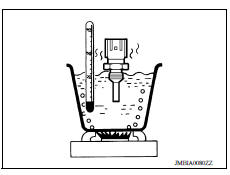Nissan Versa (N17): P0125 ECT sensor
DTC Logic
DTC DETECTION LOGIC
NOTE:
- If DTC P0125 is displayed with P0116, first perform the trouble diagnosis for DTC P0116. Refer to EC, "DTC Logic".
- If DTC P0125 is displayed with P0117 or P0118, first perform the trouble diagnosis for DTC P0117 or P0118. Refer to EC, "DTC Logic".
| DTC No. | Trouble diagnosis name | DTC detecting condition | Possible cause |
| P0125 | ECT SENSOR (Insufficient engine coolant temperature for closed loop fuel control) |
|
|
DTC CONFIRMATION PROCEDURE
1.PRECONDITIONING
If DTC Confirmation Procedure has been previously conducted, always perform the following procedure before conducting the next test.
- Turn ignition switch OFF and wait at least 10 seconds.
- Turn ignition switch ON.
- Turn ignition switch OFF and wait at least 10 seconds.
>> GO TO 2.
2.CHECK ENGINE COOLANT TEMPERATURE SENSOR FUNCTION
 With CONSULT
With CONSULT
- Turn ignition switch ON.
- Select "DATA MONITOR" mode of "ENGINE" using CONSULT.
- Check that "COOLAN TEMP/S" is above 10C (50F).
 With GST
With GST
Follow the procedure "With CONSULT" above.
Is it above 5C (41F)?
YES >> INSPECTION END
NO >> GO TO 3.
3.PERFORM DTC CONFIRMATION PROCEDURE
 With CONSULT
With CONSULT
- Start engine and run it for 65 minutes at idle speed.
- Check 1st tip DTC.
If "COOLAN TEMP/S" indication increases to more than 10C (50F) within 65 minutes, stop engine because the test result will be OK.
CAUTION: Be careful not to overheat engine.
 With GST
With GST
Follow the procedure "With CONSULT" above.
Is 1st trip DTC detected?
YES >> Proceed to EC, "Diagnosis Procedure".
NO >> INSPECTION END
Diagnosis Procedure
1.CHECK ENGINE COOLANT TEMPERATURE SENSOR
Check the engine coolant temperature sensor. Refer toEC, "Component Inspection".
Is the inspection result normal?
YES >> GO TO 2.
NO >> Replace engine coolant temperature sensor. Refer to CO, "Exploded View".
2.CHECK THERMOSTAT OPERATION
When the engine is cold [lower than 70C (158F)] condition, grasp lower radiator hose and confirm the engine coolant does not flow.
Is the inspection result normal?
YES >> Check intermittent incident. Refer to GI, "Intermittent Incident".
NO >> Repair or replace thermostat. Refer to CO, "Removal and Installation".
Component Inspection
1.CHECK ENGINE COOLANT TEMPERATURE (ECT) SENSOR
- Turn ignition switch OFF.
- Disconnect ECT sensor harness connector.
- Remove ECT sensor.
- Check resistance between ECT sensor terminals by heating with hot water as shown in the figure.


Is the inspection result normal?
YES >> INSPECTION END
NO >> Replace engine coolant temperature sensor. Refer to CO, "Exploded View".
Other materials:
Precautions when starting and driving
WARNING
Do not leave children or adults who
would normally require the assistance
of others alone in your vehicle. Pets
should also not be left alone. They
could accidentally injure themselves or
others through inadvertent operation of
the vehicle. Also, on hot, sunny days,
tempera ...
Recommended fluids/lubricants and capacities
The following are approximate capacities. The actual refill capacities may
be a little different. When refilling, follow the procedure
described in the "Do-it-yourself" section to determine the proper refill
capacity.
...
Categories
- Manuals Home
- Nissan Versa Owners Manual
- Nissan Versa Service Manual
- Video Guides
- Questions & Answers
- External Resources
- Latest Updates
- Most Popular
- Sitemap
- Search the site
- Privacy Policy
- Contact Us
0.0071

 P0122, P0123 TP sensor
P0122, P0123 TP sensor